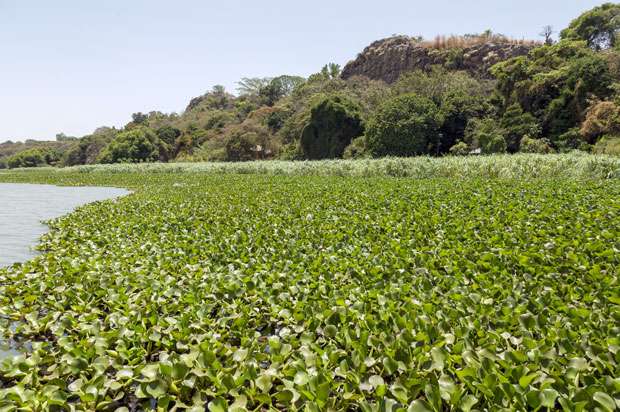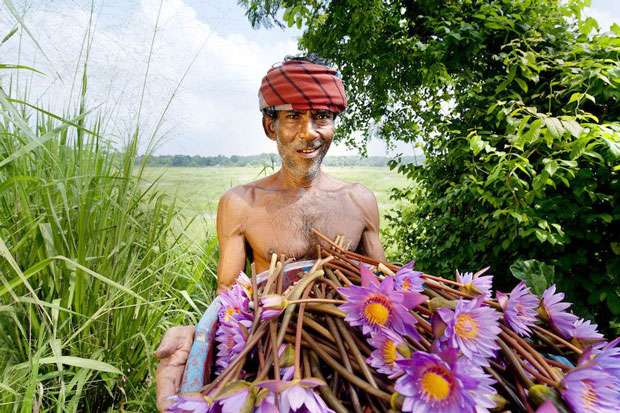Reply To:
Name - Reply Comment
Last Updated : 2024-04-25 04:58:00

 Colombo is one of the first 18 cities that have been accredited as a Ramsar Wetland City at the 13th meeting of the Conference of the Parties to the Convention (COP13) held on October 25, 2018 in Dubai, United Arab Emirates.
Colombo is one of the first 18 cities that have been accredited as a Ramsar Wetland City at the 13th meeting of the Conference of the Parties to the Convention (COP13) held on October 25, 2018 in Dubai, United Arab Emirates.
The awarding of Wetland City Accreditation taken place in accordance to the Resolution XII.10 on Wetland City Accreditation, approved by COP12 in 2015, is an honour and reflection of hard work of the urban planners, agencies and scientists of the country. While conservationists and the Sri Lankan Government are excited about the landmark achievement, it should also be borne in mind that this award brings an obligation to all parties to sustain the vital green wetlands and ecosystem services these wetlands provide by abiding to the UN’s Sustainable Development Goals (SDGs). Which means, Colombo should monitor and track progress in conserving and sustainable use of green infrastructure and will have to justify retention of the accreditation for the next six years -- the Independent Advisory Committee will review the status of the accredited Wetland City in every six years (Resolution XII.10: Wetland City Accreditation of the Ramsar Convention, 2015).
Wetlands comprise of a combination of water, soils, flora and fauna and the interaction between elements allow this green infrastructure to perform several functions that are beneficial to humankind as well as the environment
The Asian Wetland Directory describes that the country has 41 wetland sites of international importance covering an area of 274,000ha out of which the Colombo Wetland Complex covers 1,900ha – which is almost eight per cent of the city’s total area (S.S. Atapattu, S.D. Silva, S.S. Sellamuttu).
The 18 Wetland Cities accredited at COP13:
China – Changde City, Changshu City, Dongying City, Haikou City, Haerbin City, Yinchuan City; France – Amiens, Courteranges, Pont-Audemer, Saint-Omer; Hungary – Tata; Republic of Korea – Changnyeong County, Inje County, Jeju City, Suncheon City; Madagascar – Mitsinjo; Sri Lanka – Colombo; Tunisia – Ghar el Melh (Source: COP13 Conference Report, 2018).

WHAT ARE WETLANDS?
According to (S.W. Kotagama, C.N.B. Bambaradeniya, 2006), wetlands are habitats with permanent or temporary accumulation of water with associated floral and faunal communities. The Ramsar Convention further elaborated the term as “areas of marsh, fen, peat land or water, whether natural or artificial, permanent or temporary with water that is static or flowing, fresh, brackish or salt, including areas of marine water the depth of which at low tide does not exceed six metres.”
Wetlands of Sri Lanka can be divided into three broad categories as inland natural fresh water wetlands (e.g. rivers, streams, marshes, swamp forests and villus), marine and salt-water wetlands (e.g. lagoons, estuaries, mangroves, sea grass beds and coral reefs) and man-made wetlands (e.g. tanks, reservoirs, rice fields and salterns).
WETLANDS PROVIDE NUMEROUS SERVICES
Wetlands comprise of a combination of water, soils, flora and fauna and the interaction between elements allow this green infrastructure to perform several functions that are beneficial to humankind as well as the environment. The combination of these functions, together with the rich bio-diversity and cultural heritage of wetlands, makes these ecosystems invaluable to people all over the world. The services a wetland provides can be classified into four broad groups including provisioning services, regulating services, cultural services and supporting services.

SERVICES – COMMENTS AND EXAMPLES
Provisioning; Food, fresh water, fibres and fuel, biochemical, genetic material
Regulating; Climate regulation, water regulation (hydrological flows), water purification and waste treatment, erosion regulation, natural hazard regulation, pollination
Cultural; Spiritual and inspirational ecosystems, recreational, aesthetic and educational
Supporting; Soil formation, nutrient cycling and biodiversity
Sediment retention and accumulation of organic matter
“This green infrastructure plays vital hydrological regulating functions such as surface water holding, groundwater recharge, flow regulation, flood mitigation and water-quality control. Due to their importance in the hydrological cycle the wetlands are considered as a key component in strategies for Integrated Water Resources Management (IWRM)” -- (M.M. Cartney, L. Rebelo, S.S. Sellamuttu, S.D. Silva, 2010).

ARE WETLANDS VULNERABLE?
Whatsoever the wetlands are dynamic ecosystems that change over time as a consequence of natural phenomena such as soil erosion, sedimentation and flooding. However, human activities, both within the wetland or in the catchment can influence these natural processes and accelerate the rate of change, threatening the wetland’s sustainability and even the existence. Kotagama S.W. summerised the threats to wetlands in Sri Lanka under four major categories; habitat deterioration/degradation, direct loss/exploitation of species, spread of invasive alien species and natural phenomena. Farming in the river basins and upstream combined with heavy usage of agrochemicals are major threats to both fresh water and manmade wetlands.
The seeped and percolated chemicals are often responsible for the degradation of water quality in the downstream as well as deteriorate the wetland habitats. Soil erosion due to unprotected upstream agricultural practices which enhances the sedimentation is seen as a potential threat that will increase with the intensification of agriculture.
Coastal erosion on the other hand is another problem, which is brought about by altered currents and sediment loads, and can also be caused by coastal land uses such as unauthorised constructions. Reclamation for urban development, solid waste/garbage disposal and sand mining contributes to alter the structure of the wetland. Wetland habitat deterioration can be occurred due to clearing vegetation especially in the coastal belt and unauthorised and untreated sewage dumping to urban wetlands. The unplanned irrigation structures, regulation of water flow through large water infrastructure i.e. dams and mini hydro resulted in degradation of the quality of wetlands.
Wetland dependent communities rely on them for their income generation as well as living. Overexploitation of associated fauna and flora by these communities resulted in risking the extinction of several species. The most visible examples are fisheries and water birds that are being poached for consumption, while less visible but important changes may also take place in the micro faunal communities that support the ecology of the system and the food chain. Tourism as well as freshwater recreation and trade of ornamental plants and species polluted the eco-system, which leads to the loss of native species in the wetlands.
The introduced exotic aquatic animal and plant species can be eventually escaped into wild habitats can create serious threat to native aquatic biodiversity. The ornamental fish trade mostly established around water bodies has become the sole contributor to introducing invasive alien aquatic species in Sri Lanka. The most prominent examples that can be seen in local wetlands are these four species of fauna (Tilapia - Oreochromis mossambicus, Walking catfish - Clarias batrachus, Rainbow Trout - Oncorhynchus mykiss and Mosquito fish - Gambusia affinis) and two species of flora (Water Hyacinth - Eichhornia crassipes and Giant Mimosa - Mimosa pigra) that are also included in the list of the world’s 100 worst invasive alien species (100 of the World’s worst invasive alien species, 2004). The spreading of alien invasive species can lead to direct exploitation of native species as it creates a competition for limited resources. The agricultural pests/weeds can also be threatened through this while deteriorating the quality of the wetlands.
“Despite all the services they provide wetlands worldwide continuously threatened in different forms by human activities, and Sri Lanka is no exception. Reclamation and clearing for urban expansion, unsustainable solid waste disposal from domestic and industrial sources and the release of industrial, domestic and commercial waste have greatly diminished the health of the wetland ecosystem. Recent increases in flood damages and declining of aquatic biodiversity are, in part, the results of wetlands degradation and destruction. In this context, conservation of our natural heritage is the duty of any responsible citizen,” said Prof. Deepthi Wickramasinghe, Head/Department of Zoology and Environment Sciences, Colombo University.
Wetlands are also threatened by natural phenomena which are also common in Sri Lanka. For instance, the prolonged dry conditions in the dry zone results drying off of tanks, streams, salt marshes and lagoons, causing death to several species of flora and fauna. The rise of seawater temperature due to climate change bleaches the coral reefs, especially in the southwestern part of Sri Lanka.
STEPS TAKEN TO PROTECT WETLANDS
The vigilance for wetland conservation reached high in Sri Lanka with the high intensity and frequent flash floods that occurred in the last few years around the country. Consequently, a significant Cabinet decision was taken on August 21, 2018 by President Maithripala Sirisena in his capacity as the Mahaweli Development and Environment Minister, by providing the following recommendations;
- to impose a prohibitory order preventing all types of land reclamation and constructions in the Colombo metropolitan region for any purpose other than the constructions necessary to be done which are of national importance and the constructions identified under the Transit Railway Line Network.
- to direct the Director-General of Wildlife to declare the wetlands, other than the areas recognised adjacent to Kimbulaela and Diyawanna Oya in which the development activities have already been initiated, as protected areas.
Sri Lanka ratified the Ramsar Convention on Wetlands in 1990 and established its National Wetland Steering Committee (NWSC) while the committee was reconstituted in 2003 to integrate plans for wetland areas and to coordinate development and conservation activities. This resulted in the formal adoption of a national wetland policy under the auspices of the Environment and Natural Resources Ministry in 2004.
Since 1897, with the broadcasting of “protect the coastal belt systems,” Sri Lanka has taken major steps towards conserving its wetlands. The Fauna and Flora Protection Ordinance of 1937 can be considered as another giant step. Using this legislation, wetlands of importance to birds have been declared as sanctuaries and other protected areas by the Wildlife Conservation Department. In between, establishment of a Wetland Steering Committee, hosting international workshops on wetlands and declaring six Ramsar wetland sites (Bundala, Anawilundawa, Madu ganga, Venkali Santuary, Kumana Wetland Cluster and Wilpattu Wetland) showed the country’s willingness to protect these valuable water bodies.
Currently, the Sri Lankan Government, non-governmental organisations, research organisations and academia as well as the corporate sector are involved in wetland conservation and management related activities in the country.
“The National Wetland Policy published in 2006 highlighted the need for an effective institutional mechanism to coordinate wetland conservation activities in the country. As a result, a wetland management unit has been established at the Central Environmental Authority (CEA) for overall coordination of wetland activities in the country. Accordingly, we have identified Environmental Protection Areas (EPAs), as per provisions of the National Environmental Act No.47 of 1980, which also includes six wetlands sites. The CEA shall exercise, perform and discharge any powers, duties, functions related to planning and development, within such protection areas,” said Mrs. Priyangani Gunathilaka, Acting Directress, Natural Resources and Catchment Programme, CEA.
SUGGESTION TO WETLAND MANAGEMENT
We all have a role to play in sustainable wetlands management – to ensure the wetland dependent communities continue to obtain the benefits that wetlands provide for reducing poverty and to ensure balanced ecosystems. The book on ‘Wetlands and People’ suggests a ‘people-centred approach’ to wetland management – a balanced approach that seeks to optimise the benefits for poor people, including through appropriate wetland agriculture, while simultaneously protecting vital ecosystem services – is essential if wetlands are to be conserved for future generations. This people-centred approach complements the ‘wise use’ principle put forward by the Ramsar Convention on Wetlands in 1987.
Wetland policies need to better reflect the realities of wetland agriculture – the dilemma remains as to how to maximise the benefits of agriculture whilst simultaneously minimising the adverse impacts on other valuable ecosystem services. Research is required to better understand trade-offs and determine best management practices.
“Moving from wetland protection alone to integrating conservation and development is a significant step – because managing wetlands together with the fast growing economy, urbanisation and infrastructure development while supporting people’s livelihoods will not always be totally corresponding with managing them for conservation objectives. There will often be conflicts and trade-offs between people’s desires and conservation; these require skillful and innovative forms of management,” said Mr. Pay Drechsel, Senior Resercher at IWMI who also represents Thalangama Wetland Watch.

Add comment
Comments will be edited (grammar, spelling and slang) and authorized at the discretion of Daily Mirror online. The website also has the right not to publish selected comments.
Reply To:
Name - Reply Comment
US authorities are currently reviewing the manifest of every cargo aboard MV
On March 26, a couple arriving from Thailand was arrested with 88 live animal
According to villagers from Naula-Moragolla out of 105 families 80 can afford
Is the situation in Sri Lanka so grim that locals harbour hope that they coul